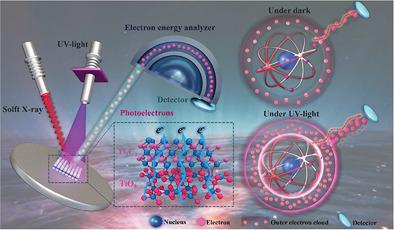当前位置:
X-MOL 学术
›
Small Methods
›
论文详情
Our official English website, www.x-mol.net, welcomes your
feedback! (Note: you will need to create a separate account there.)
Photogenerated Electron Transfer Process in Heterojunctions: In Situ Irradiation XPS
Small Methods ( IF 10.7 ) Pub Date : 2020-06-18 , DOI: 10.1002/smtd.202000214 Peng Zhang 1, 2, 3 , Yukun Li 1, 2 , Yongshang Zhang 1, 2, 3 , Ruohan Hou 1, 2 , Xilai Zhang 1, 2 , Chao Xue 1, 2 , Shaobin Wang 4 , Bicheng Zhu 5 , Neng Li 5 , Guosheng Shao 1, 2, 3
Small Methods ( IF 10.7 ) Pub Date : 2020-06-18 , DOI: 10.1002/smtd.202000214 Peng Zhang 1, 2, 3 , Yukun Li 1, 2 , Yongshang Zhang 1, 2, 3 , Ruohan Hou 1, 2 , Xilai Zhang 1, 2 , Chao Xue 1, 2 , Shaobin Wang 4 , Bicheng Zhu 5 , Neng Li 5 , Guosheng Shao 1, 2, 3
Affiliation

|
Photoelectron transfer between heterojuctions is an important process for photocatalysis, and identification of the electron transfer process provides valuable information for catalyst design. Herein, Ti3C2, one of the widely used two‐dimensional materials, is used to produce a heterojunction of TiO2 and Ti3C2 by an in situ growth method and the photogenerated electrons transfer between the two components for photocatalytic water splitting to hydrogen is investigated. Theoretical simulation and experimental tests proclaim that electrons transfer from Ti3C2 to TiO2 forms an internal electric field, which implies that there exists the driving force of electronic movement from TiO2 to Ti3C2. In situ irradiation X‐ray photoelectron spectroscopy shows the binding energies of TiC (in Ti3C2) and TiO (in TiO2) move toward negative and positive positions, respectively, verifying the photogenerated electrons produced from TiO2 and transferring to Ti3C2 driven by the internal electric field. In addition, the amount of TiO2 nanoparticles also affects the hydrogen evolution rate. Several parallel experiments are designed to uncover the fact that less or excess amount of TiO2 nanoparticles leads to a tinier shift of binding energy, which hints the quantity of heterojunction is a considerable factor in photocatalytic performance. This work develops a new method to directly monitor the photoelectron transfer process between heterojuctions.
中文翻译:

异质结中的光生电子转移过程:原位辐照XPS
异质结之间的光电子转移是光催化的重要过程,电子转移过程的鉴定为催化剂设计提供了有价值的信息。这里,钛3 Ç 2,广泛使用的两维材料中的一种,是用于生产的TiO构成的异质结2和Ti 3 c ^ 2通过原位生长方法和光生电子的两个组件之间传送用于光催化分解水对氢进行了研究。理论模拟和实验测试表明,电子从Ti 3 C 2转移到TiO 2形成内部电场,这意味着存在从TiO 2到Ti 3 C 2的电子运动的驱动力。原位辐射X射线光电子能谱显示TiC(在Ti 3 C 2中)和TiO(在TiO 2中)的结合能分别朝负和正位置移动,验证了TiO 2和TiO 2产生的光生电子。在内部电场的驱动下转移到Ti 3 C 2。另外,TiO 2的量纳米颗粒也影响氢的释放速率。设计了多个平行实验以揭示以下事实:较少或过量的TiO 2纳米颗粒会导致结合能的微小变化,这表明异质结的数量是光催化性能的重要因素。这项工作开发了一种直接监视异质结之间的光电子转移过程的新方法。
更新日期:2020-06-18
中文翻译:

异质结中的光生电子转移过程:原位辐照XPS
异质结之间的光电子转移是光催化的重要过程,电子转移过程的鉴定为催化剂设计提供了有价值的信息。这里,钛3 Ç 2,广泛使用的两维材料中的一种,是用于生产的TiO构成的异质结2和Ti 3 c ^ 2通过原位生长方法和光生电子的两个组件之间传送用于光催化分解水对氢进行了研究。理论模拟和实验测试表明,电子从Ti 3 C 2转移到TiO 2形成内部电场,这意味着存在从TiO 2到Ti 3 C 2的电子运动的驱动力。原位辐射X射线光电子能谱显示TiC(在Ti 3 C 2中)和TiO(在TiO 2中)的结合能分别朝负和正位置移动,验证了TiO 2和TiO 2产生的光生电子。在内部电场的驱动下转移到Ti 3 C 2。另外,TiO 2的量纳米颗粒也影响氢的释放速率。设计了多个平行实验以揭示以下事实:较少或过量的TiO 2纳米颗粒会导致结合能的微小变化,这表明异质结的数量是光催化性能的重要因素。这项工作开发了一种直接监视异质结之间的光电子转移过程的新方法。











































 京公网安备 11010802027423号
京公网安备 11010802027423号